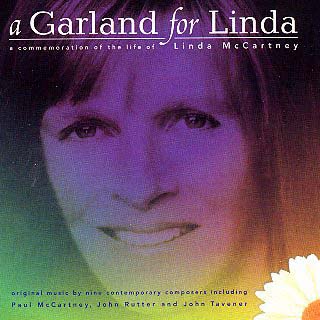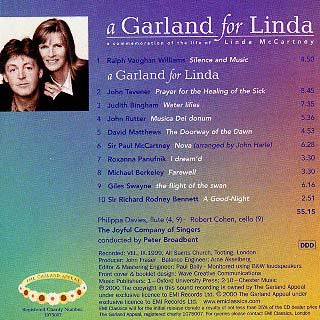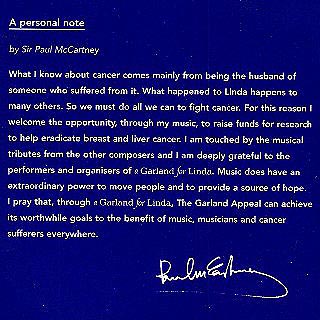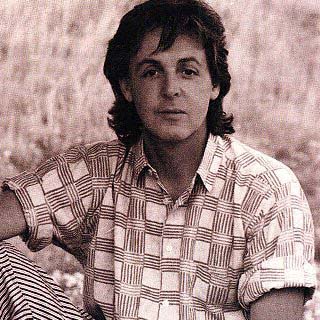



The Joyful Company of Singers - conducted by Peter Breadbent
a commemoration of the life of Linda McCartney
original music by nine contemporary composers including
Paul McCartney, John Rutter and John Tavener
| Disclaimer Images used, herein, are owned by the individual copyright holders and are presented for review and promotional purposes only. |
Ausschlussklausel Hier dargestellte Bilder sind Eigentum der jeweiligen Rechteinhaber. Sie sind ausschließlich zum Zwecke der Rezension und der Promotion dargestellt. |
 |
 |
 |
 |
UK: EMI Classics, 7243 5 56961 2
| Tr | Composer | Title | Time |
| 1 | Ralph Vaughan Williams | Silence and Music | 4:50 |
| a Garland for Linda | |||
| 2 | John Tavener | Prayer for the Healing of the Sick | 8:45 |
| 3 | Judith Bingham | Water lilies | 7:35 |
| 4 | John Rutter | Musica Dei donum | 5:36 |
| 5 | David Matthews | The Doorway of the Dawn | 4:53 |
| 6 | Sir Paul McCartney | Nova (arranged by John Harle) | 6:28 |
| 7 | Roxanna Panufnik | I dream'd | 3:30 |
| 8 | Michael Berkeley | Farewell | 3:30 |
| 9 | Giles Swayne | the flight of the swan | 6:16 |
| 10 | Sir Richard Rodney Bennett | A Good-Night | 2:51 |
| Order the CD: | Buy it at Amazon.co.uk | |
| Germany, release date 11 February | United Kingdom, release date 7 February |
A Garland for Linda was premiered at the Charterhouse School in July 1999 at a concert at which all nine living composers were present. The performance officially launched the Garland Appeal, which aims to raise £2 million and to see A Garland for Linda performed at least 200 times world-wide during the next three years. The launch of the album has taken place on 27th January at St Andrew’s Church in Holborn, London – where a special concert has featured all the works on the new album, and was attended by Sir Paul McCartney and several of the other composers.
EMI Classics is donating a royalty from the initial CD release to the Garland Appeal.
1. Ralph Vaughan Williams (1872-1958) Silence and Music
Silence and Music, composed to words by Ursula Vaughan Williams, was the fourth of ten works in A Garland for the Queen, in which ten British composers and ten poets paid tribute to Queen Elizabeth II in 1953, the year of her coronation.
2. John Tavener Prayer for the Healing of the Sick
John Tavener, who studied at the Royal Academy of Music with Lennox Berkeley, among others, was also an extremely gifted pianist but chose composition; his early compositions appeared on the Beatles’ Apple label.
Against the background of a strict Presbyterian upbringing, he joined the Russian Orthodox Church in 1977 and this strongly influenced his style. The reflective and meditative qualities of his compositions spring both from the Orthodox tradition and from his own experience of illness. The text for Prayer for the Healing of the Sick is by Mother Thekla and is taken from the Russian Orthodox Service of Holy Unction, a service performed for the composer when he underwent open heart surgery in 1991. It is a contemplative piece that the composer intends to be ‘almost inaudible, just like the gentle touch of a hand.’
3. Judith Bingham Water lilies
Judith Bingham, who was born in Nottingham in 1952, attended the Royal Academy of Music to study composition and singing. She wrote the poem and the music to Water lilies in March 1999, drawing on her experience of swimming through a raft of water lilies in a mountain lake in Bavaria the previous year. She thought of the flowers during the winter and realised that they were undoubtedly frozen, the buds suspended in ice. But she also knew that they would bloom again the following summer and she saw this as a parallel with people who are ill, in that hope is possible, even in one’s darkest moments.
4. John Rutter Musica Dei donum
John Rutter’s music has been influenced by Britten, Walton and Howells, as well as by American composers including Copland and Barber. Musica Dei donum is taken from a text known only from Lassus’s musical setting, which was first published in 1594. Rutter’s setting was originally commissioned by Clare College Cambridge but the composer wanted to contribute it to A Garland for Linda because of its theme of the power of music to ‘uplift sad minds’.
5. David Matthews The Doorway of the Dawn
David Matthews, whose Fifth Symphony was premiered at the 1999 Proms, has studied with Anthony Milner, Nicholas Maw and Deryck Cooke. He also worked with Benjamin Britten for three years and is an admirer of Michael Tippett, about whom he has written a book.
David Matthews met Paul McCartney in 1995 and worked with him on Standing Stone. He also met Linda McCartney, whose optimism and determination to live life to the full made a deep impression on him. He wanted to write a work for her that reflected her fighting qualities. For his text he chose a Pima Indian poem sent to him from Phoenix, Arizona, an area Paul and Linda also loved.
6. Sir Paul McCartney Nova
Nova was written for A Garland for Linda to a text by the composer. To the question ‘Are You there? God where are You?’ comes the answer ‘I am here in every song you sing’. The questioning first stanza is ambiguous in terms of key; the answer, in the second stanza, however, has a clearer tonality and demonstrates McCartney’s lyrical and melodic gifts.
7. Roxanna Panufnik I’d dream’d
Roxanna Panufnik, who studied at the Royal Academy of Music with Hans Werner Henze, among others, has written a wide range of pieces including opera, ballet, music theatre, choral works, chamber music and music for film and television. She arranged I dream’d from a work she had composed as part of an environmental cantata during the illness of her father, the composer Andrzej Panufnik. Based on the poem by Tennyson, it is a spiritual and uplifting piece that turns from melancholy and desolation to a transcendental vision.
8. Michael Berkeley Farewell
Michael Berkeley - the eldest son of the composer Lennox Berkeley, a contributor to the 1953 A Garland for the Queen - is active as a composer and broadcaster and as Artistic Director of the Cheltenham International Festival since 1995. The musical idea for Farewell, a short valedictory lullaby, preceded the choice of text, which is in the form of reworked fragments of literary ideas from Milton, Shakespeare and Elizabeth Speller. The mood of the work is essentially wistful and gentle with moments of grief.
9. Giles Swayne the flight of the swan
Giles Swayne attended composition classes with Olivier Messiaen after studying at the Royal Academy of Music. His interest in African musical tradition later led him to Gambia and southern Senegal. His latest choral work, Havoc, was premiered at the Proms in 1999.
the flight of the swan was inspired by the death of James Manson, the son of a close friend, from brain cancer in 1996. The poem on which the work is based dates from the ninth or tenth century and was intended as a Sequence, a free composition interpolated in the Mass between the Gradual and the Gospel. It tells of a swan flying across an ocean and blown off course because the stars by which it navigates are hidden by storm clouds. But the swan struggles bravely on and when dawn breaks and the clouds part, it regains confidence and soars into the open sky.
10. Sir Richard Rodney Bennett A Good-Night
Richard Rodney Bennett studied with Lennox Berkeley, Howard Ferguson and Pierre Boulez. His works are known for their richness of invention. In the 1960s his enthusiasm for jazz prompted him to write a number of works in a sophisticated jazz style. He is also a gifted pianist, excelling in the classical and jazz repertoire. Recent works include Calico Pie, a setting for chorus of five poems of Edward Lear and Reflections on a 16th Century Tune.
A Good-Night, composed to a poem by Francis Quaries, is a simple and gentle piece. Richard Rodney Bennett knew Linda McCartney, who he found to be always warm and spontaneous. He wanted this work to be ‘a gentle goodbye to a remarkable woman’.
©2000 PLUGGED - the unofficial Paul McCartney Homepage